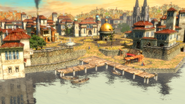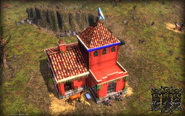| Civilization | Technology Tree | Home City |
|---|
"Herdables spawn automatically from Pastures. Cavalry units move faster with each Age Up. National Guards: Escolta Libertad and Jinete Choiquero. Immigrants: Italians, Polish and Scandinavians." ― In-game description.
Overview[]
The Argentines are a Latin American civilization in Age of Empires III: Wars of Liberty. They are a nation of people used to life on their saddles, feeling more comfortable moving and working atop their steeds.
- Their economy depends heavily on their herds of animals, and when they go to war the speed of their cavalry and the quick transportation of their battalions to the battlefield is what helps them emerge victorious.
Features[]
- Have mounted Villagers which move faster than generic Villagers.
- Have a mounted Explorer which has great mobility and can use the Crack Shot ability instantly.
- Cavalry gains more speed with each Age-up(Age lI +2,5%, Age III +2,5%, Age IV +2,5% and Age V +2,5%= +10% at the end of the game having advanced all ages)
- Pasture spawn cows over time.
- Access to the following National Guard units: Escolta (Libertad), Jinete (Choiquero).
Units[]
[]
 Conscript: Heavy ranged infantry. Good against cavalry in melee.
Conscript: Heavy ranged infantry. Good against cavalry in melee. Lancer: Hand cavalry good at killing archers, skirmishers, and artillery.
Lancer: Hand cavalry good at killing archers, skirmishers, and artillery. Jinete: Ranged Latin American cavalry. Good against cavalry.
Jinete: Ranged Latin American cavalry. Good against cavalry. Escolta: Heavy melee cavalry. Good against heavy infantry in melee.
Escolta: Heavy melee cavalry. Good against heavy infantry in melee. Artisanal Cannon: Cheap artillery that can be repositioned quickly. Good against infantry.
Artisanal Cannon: Cheap artillery that can be repositioned quickly. Good against infantry. Volante: Quick-moving cannon with high rate of fire. Good against other artillery.
Volante: Quick-moving cannon with high rate of fire. Good against other artillery. Pedrero: Latin American mortar. Good against buildings.
Pedrero: Latin American mortar. Good against buildings. Exploding Cart: Siege wagon that dies when it attacks buildings but does lots of damage.
Exploding Cart: Siege wagon that dies when it attacks buildings but does lots of damage.
Unique Units[]
 Fortinero: Explorer. Counts as a Manoeuvre Unit.
Fortinero: Explorer. Counts as a Manoeuvre Unit. Gaucho: Mounted villager. Faster than normal Villagers and counts as Shock unit.
Gaucho: Mounted villager. Faster than normal Villagers and counts as Shock unit. Zebu: Unique large capacity herdable trained from the Estancia.
Zebu: Unique large capacity herdable trained from the Estancia. Patricio: Argentinian ranged infantry, good against Manoeuvre Units at range and Scout Units in melee.
Patricio: Argentinian ranged infantry, good against Manoeuvre Units at range and Scout Units in melee. Infernale: Fast-moving hand cavalry that deals bonus to Shock Units.
Infernale: Fast-moving hand cavalry that deals bonus to Shock Units. Horse Grenadier: Ultimate unit. A Hand Cavalry unit that throws a grenade before engaging in melee combat.
Horse Grenadier: Ultimate unit. A Hand Cavalry unit that throws a grenade before engaging in melee combat.
Unique Buildings[]
- Estancia: Ultimate building. A powerful version of a Livestock Pen that fattens livestock faster and in larger quantities. Can train the Zebu as well as cavalry units. Trains and upgrades Horse Grenadiers.
- Pasture: Building that replaces the Hacienda. Spawns Cows, can fatten livestock and Villagers can use it as a Hacienda.
Immigrants[]
In-game Dialogue[]
General[]
- ¿Si? (Yes?)
- ¿Qué me ordena? (What is my order?)
- Preparado (Ready)
- ¿Hola? (Hello?)
- Correcto (Correct)
- Lo haré (I’ll do it)
- Voy a hacerlo (I’m going to do it)
- ¡A la guerra! (To war!)
Gaucho[]
- Build Constructor - Builder
- Farm Granjero - Farmer
- Meat Cazador - Hunter
- Coin Minero - Miner
- Wood Leñador - Lumberjack
Mounted explorer[]
- Disabled Estoy herido y no puedo moverme - I'm hurt and I can’t move
- Revived Ahora me siento más fuerte - I feel stronger now
Trivia[]
- Argentina was one of the first civilizations added to the mod, after Brazil and alongside Paraguay.
- The Warchiefs version of the civilization featured a bonus where cows would reproduce, but only if controlled by the Argentine player.
History[]
The 1810 May Revolution replaced the viceroy Baltasar Hidalgo de Cisneros with the First Junta, a new government in Buenos Aires composed by locals. In the first clashes of the Independence War the Junta crushed a royalist counter-revolution in Córdoba, but failed to overcome those of the Banda Oriental, Upper Peru and Paraguay, which later became independent states.
Revolutionaries split into two antagonist groups: the Centralists and the Federalists—a move that would define Argentina's first decades of independence. The Assembly of the Year XIII appointed Gervasio Antonio de Posadas as Argentina's first Supreme Director.
On 9 July 1816, the Congress of Tucumán formalized the Declaration of Independence, which is now celebrated as Independence Day, a national holiday. One year later General Martín Miguel de Güemes stopped royalists on the north, and General José de San Martín took an army across the Andes and secured the independence of Chile; then he led the fight to the Spanish stronghold of Lima and proclaimed the independence of Peru. In 1819 Buenos Aires enacted a centralist constitution that was soon abrogated by federalists.
Gallery[]
Changelog[]
- 1.0.13c
- -Gobierno de Rosas card no longer costs Coin to ship.
Portals
| Civilizations · Details | |
|---|---|
| Africans | |
| Anglos | |
| Asians | |
| Europeans | |
| Latin Americans | |
| Middle Easterners* | |
| Nation States | |
| Native Americans | |
| Polynesians | |
| *Coming Soon | |
| Minor Allies · Details | |
|---|---|
| African Commodities | Broken - WIP |
| American Natives | |
| Asian Religious Orders | |
| European Towns | Coming Soon |
| Latin American Towns | |
| Oceanian Immigrants | |
| Polynesians | |
| Others | |
| Obsolete | |
| *Coming Soon | |


